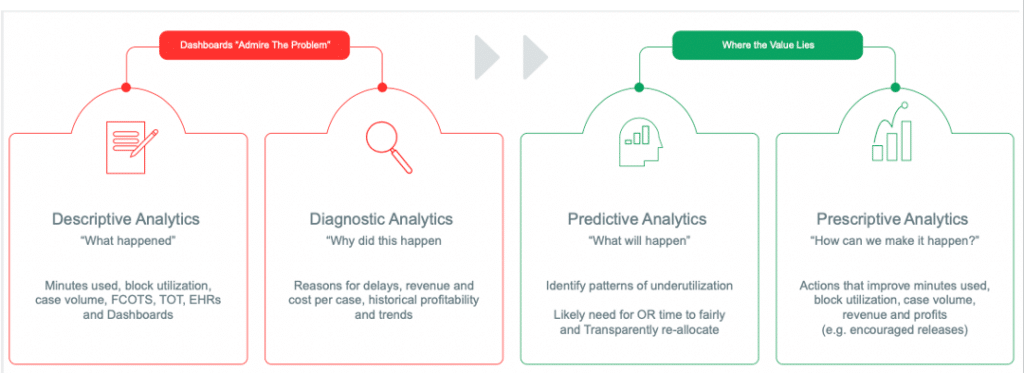The world of healthcare analytics — in fact, all analytics — is not monolithic. It ranges from solutions that admire problems to those that prescribe actions to create value.
The further hospitals and health systems move to the right of this spectrum (i.e. using analytics that create valuable prescriptions rather than just describing them), the more they will experience the true benefits of healthcare analytics.

Descriptive analytics admire the problem
The most common forms of analytics are descriptive. They merely admire the problem. Think of getting on a scale or using a thermometer. Before doing so, most people have a defined hypothesis they want to confirm about their weight or their temperature. The answer they receive from these tools confirms or denies their hypothesis. It does not tell them the underlying cause for the output nor what they should do with that information moving forward.
Similarly, in healthcare there are multitudes of dashboards and reports that committees and leaders receive from EHRs, Excel, Tableau, and other “analytics.” For example in the operating room (OR), historical case volumes, times, turnovers, or delays merely underline issues that were already known. This is not enough to enact meaningful change toward optimizing OR performance.
Diagnostic analytics show possible causes
Diagnostic analytics are more powerful but still insufficient. If a thermometer shows that a person has a high temperature, for instance, they can surmise that they may have caught the fever because they were out in the rain the night before and got soaking wet, or were exposed to a virus when they went inside. But this diagnosis does nothing to help cure the fever.
The slicing, dicing, and deep diving that healthcare data diagnostic dashboards provide are also like explanations of yesterday’s weather. They may be wonderful for understanding where and when last night’s storm occurred, but they aren’t forward-looking. They don’t help anyone decide whether to take an umbrella when they go out today.
Specifically in the surgical world, diagnostic analytics might help OR managers understand that Dr. Jones’ cases always run late because he habitually requests too little time and doesn’t think of his cases in terms of “wheels in to wheels out.” Diagnostic analytics in healthcare don’t actually solve anything, however, unless they can help Dr. Jones learn to request the right amount of time and let him do so easily.
Predictive analytics guide future strategy
The real power of analytics starts to come into play when we gain the ability to forecast meaningful future events. Predictive analytics can help users start to plan their actions ahead.
Google Maps predicts a driver will take 54 minutes to get home from the airport after landing at 5pm three days from now. This helps a traveler plan their evening. How does Google Maps work such magic? By mining historical data from millions of trips other drivers have taken over the years. The app has no way of knowing exactly who will be on the road during the predicted trip, nor can it rate driving skills, but it can access a lot of data upon which it can build predictive models and establish the likely drive time from point A to point B.
Timestamp data can be mined in the same way to help an OR scheduler predict which surgical block owners will not fully use their time and which non-employed surgeons could be assigned the remainder. Predictive analytics in healthcare truly add value by delivering specific information about the future to solve a problem.
Prescriptive analytics shape solutions to create value
The most useful analytics are those that drive high-value action. A tool like Waze can show an alternate route to shorten the length of the journey, and companies like FedEx and UPS use forecasting algorithms to predict the volume and mix of packages they will receive and put the right number of planes, trucks, and drivers in the right places at the right times to handle the demand.
In the healthcare analytics world, a surgical department can alter its staffing patterns for a future day on which a surge in case volumes is predicted, to “flatten the peak” and accommodate more patients. It can also predict if, say, Dr. Smith is unlikely to utilize her assigned block three weeks from today, and proactively (and automatically) request she consider releasing it so one of her colleagues could use it. This improves the utilization of the operating room assigned to Dr. Smith.
The future of healthcare data: predictive and prescriptive analytics in healthcare
To truly grow capacity, and thrive operationally and financially, hospitals and health systems need better tools with more predictive and prescriptive capability than EHR reports and dashboards can provide. Healthcare operational teams will need to go beyond describing or diagnosing problems to actually predicting what’s likely to happen and making value-adding action adjustments in anticipation—as illustrated by Waze, UPS and FedEx, and so many other real-world examples we all encounter in our day to day lives. These high-level analytics drive real ROI including the potential to achieve a 16X ROI in the operating room, decrease $8 million worth of inpatient opportunity days, and increase volumes of infusion patients with the same chair count by almost 10%.
To learn more about how healthcare institutions have used tools to employ predictive and prescriptive analytics, to optimize ROI in ORs as well as infusion centers and inpatient beds, visit our Resource Center. To explore more how high-level analytics drive healthcare ROI, view our session from our Summer 2022 Transform Hospital Operations Summit.



